小学英语重点句型语法总结.docx
小学三年级英语常用重点句型+语法知识总结
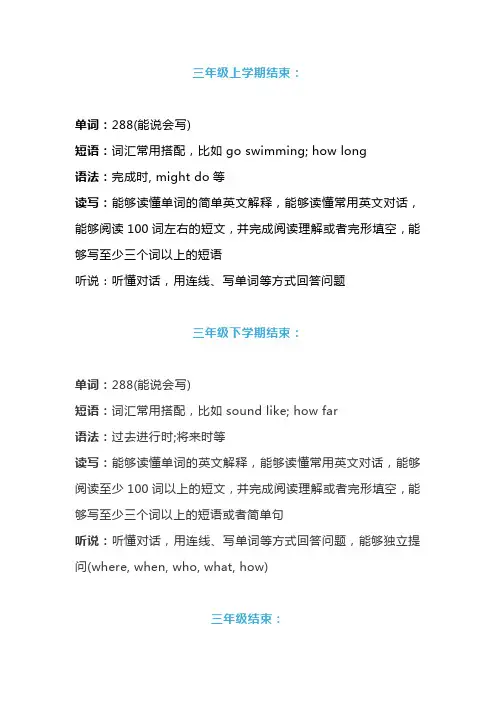
三年级上学期结束:单词:288(能说会写)短语:词汇常用搭配,比如go swimming; how long语法:完成时, might do等读写:能够读懂单词的简单英文解释,能够读懂常用英文对话,能够阅读100词左右的短文,并完成阅读理解或者完形填空,能够写至少三个词以上的短语听说:听懂对话,用连线、写单词等方式回答问题三年级下学期结束:单词:288(能说会写)短语:词汇常用搭配,比如sound like; how far语法:过去进行时;将来时等读写:能够读懂单词的英文解释,能够读懂常用英文对话,能够阅读至少100词以上的短文,并完成阅读理解或者完形填空,能够写至少三个词以上的短语或者简单句听说:听懂对话,用连线、写单词等方式回答问题,能够独立提问(where, when, who, what, how)三年级结束:背诵能力:轻松背诵100词以上短文或者对话读写:能够阅读100词以上文章,并书写3个单词词以上的英文答案听说:能够听懂简单的常用英文对话,能够使用where等疑问词独立提问小学三年级英语重点句型1. Hello!喂 Hi! 嗨2. Hello! I'm Wu Yifan. I'm from China.你好!我叫吴一凡。
我来自中国。
3. What's your name?你叫什么名字?4. My name's Chen Jie. 我的名字叫陈洁5. I have a pencil. 我有一只钢笔。
Me too.我也是。
6. Good morning.早上好Good afternoon.晚上好7. This is Miss White. 这是Miss White。
Nice to meet you. 很高兴认识你。
8. Where are you from?你来自哪里?I'm from America. 我来自美国。
9. Let's go to school.让我们一起去学校。
小学英语语法大全(完整版)(可打印)
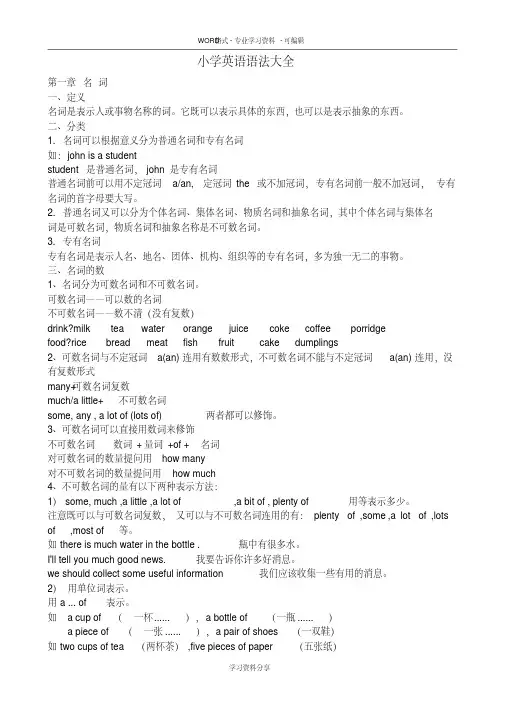
小学英语语法大全第一章名词一、定义名词是表示人或事物名称的词。
它既可以表示具体的东西,也可以是表示抽象的东西。
二、分类1. 名词可以根据意义分为普通名词和专有名词如:john is a studentstudent是普通名词,john是专有名词普通名词前可以用不定冠词a/an, 定冠词the 或不加冠词,专有名词前一般不加冠词,专有名词的首字母要大写。
2. 普通名词又可以分为个体名词、集体名词、物质名词和抽象名词,其中个体名词与集体名词是可数名词,物质名词和抽象名称是不可数名词。
3. 专有名词专有名词是表示人名、地名、团体、机构、组织等的专有名词,多为独一无二的事物。
三、名词的数1、名词分为可数名词和不可数名词。
可数名词——可以数的名词不可数名词——数不清(没有复数)drink?milk tea water orange juice coke coffee porridgefood?rice bread meat fish fruit cake dumplings2、可数名词与不定冠词a(an)连用有数数形式,不可数名词不能与不定冠词a(an)连用,没有复数形式many+可数名词复数much/a little+不可数名词some, any , a lot of (lots of) 两者都可以修饰。
3、可数名词可以直接用数词来修饰不可数名词数词 +量词 +of + 名词对可数名词的数量提问用how many对不可数名词的数量提问用 how much4、不可数名词的量有以下两种表示方法:1) some, much ,a little ,a lot of ,a bit of , plenty of 用等表示多少。
注意既可以与可数名词复数,又可以与不可数名词连用的有:plenty of ,some ,a lot of ,lots of ,most of 等。
如there is much water in the bottle .瓶中有很多水。
小学英语语法知识总结
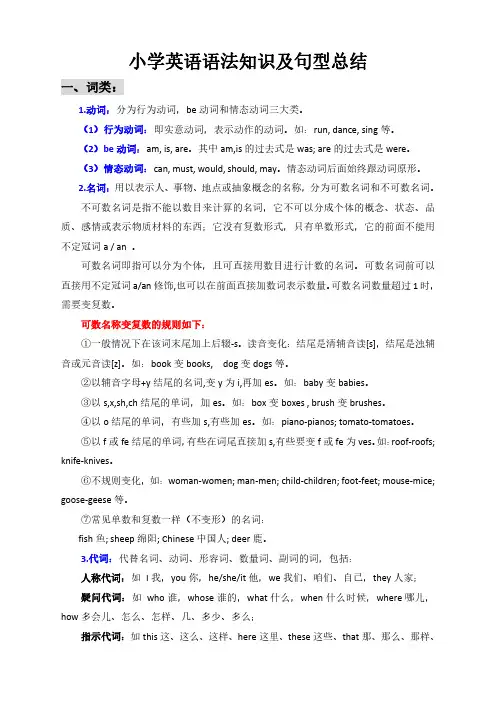
小学英语语法知识及句型总结一、词类:1.动词:分为行为动词,be动词和情态动词三大类。
(1)行为动词:即实意动词,表示动作的动词。
如:run,dance,sing等。
(2)be动词:am,is,are。
其中am,is的过去式是was;are的过去式是were。
(3)情态动词:can,must,would,should,may。
情态动词后面始终跟动词原形。
2.名词:用以表示人、事物、地点或抽象概念的名称,分为可数名词和不可数名词。
不可数名词是指不能以数目来计算的名词,它不可以分成个体的概念、状态、品质、感情或表示物质材料的东西;它没有复数形式,只有单数形式,它的前面不能用不定冠词a/an。
可数名词即指可以分为个体,且可直接用数目进行计数的名词。
可数名词前可以直接用不定冠词a/an修饰,也可以在前面直接加数词表示数量。
可数名词数量超过1时,需要变复数。
可数名称变复数的规则如下:①一般情况下在该词末尾加上后辍-s。
读音变化:结尾是清辅音读[s],结尾是浊辅音或元音读[z]。
如:book变books,dog变dogs等。
②以辅音字母+y结尾的名词,变y为i,再加es。
如:baby变babies。
③以s,x,sh,ch结尾的单词,加es。
如:box变boxes,brush变brushes。
④以o结尾的单词,有些加s,有些加es。
如:piano-pianos;tomato-tomatoes。
⑤以f或fe结尾的单词,有些在词尾直接加s,有些要变f或fe为ves。
如:roof-roofs; knife-knives。
⑥不规则变化,如:woman-women;man-men;child-children;foot-feet;mouse-mice; goose-geese等。
⑦常见单数和复数一样(不变形)的名词:fish鱼;sheep绵阳;Chinese中国人;deer鹿。
3.代词:代替名词、动词、形容词、数量词、副词的词,包括:人称代词:如I我,you你,he/she/it他,we我们、咱们、自己,they人家;疑问代词:如who谁,whose谁的,what什么,when什么时候,where哪儿,how多会儿、怎么、怎样、几、多少、多么;指示代词:如this这、这么、这样、here这里、these这些、that那、那么、那样、there那里、those那些”。
小学英语语法重点知识归纳大全
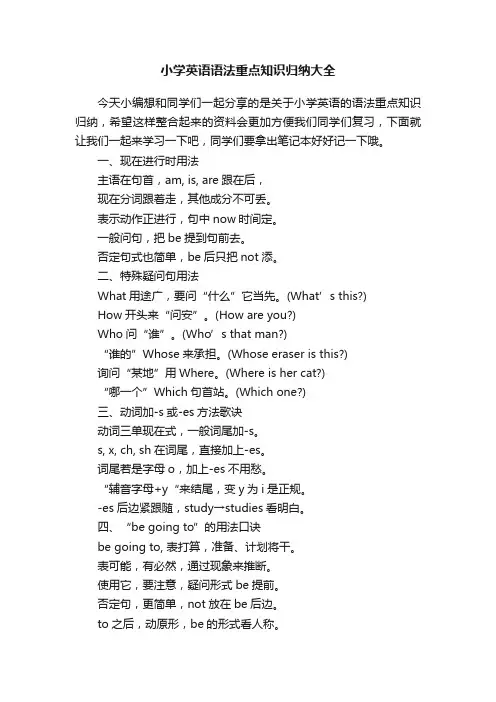
小学英语语法重点知识归纳大全今天小编想和同学们一起分享的是关于小学英语的语法重点知识归纳,希望这样整合起来的资料会更加方便我们同学们复习,下面就让我们一起来学习一下吧,同学们要拿出笔记本好好记一下哦。
一、现在进行时用法主语在句首,am, is, are跟在后,现在分词跟着走,其他成分不可丢。
表示动作正进行,句中now时间定。
一般问句,把be提到句前去。
否定句式也简单,be后只把not添。
二、特殊疑问句用法What用途广,要问“什么”它当先。
(What’s this?)How开头来“问安”。
(How are you?)Who问“谁”。
(Who’s that man?)“谁的”Whose来承担。
(Whose eraser is this?)询问“某地”用Where。
(Where is her cat?)“哪一个”Which句首站。
(Which one?)三、动词加-s或-es方法歌诀动词三单现在式,一般词尾加-s。
s, x, ch, sh在词尾,直接加上-es。
词尾若是字母o,加上-es不用愁。
“辅音字母+y“来结尾,变y为i是正规。
-es后边紧跟随,study→studies看明白。
四、“be going to”的用法口诀be going to, 表打算,准备、计划将干。
表可能,有必然,通过现象来推断。
使用它,要注意,疑问形式be提前。
否定句,更简单,not放在be后边。
to之后,动原形,be的形式看人称。
下列词,要注意,come go和离去(leave)进行时,表将来,牢牢记住莫忘记。
小学英语知识重点一、形容词性物主代词1、形容词性物主代词8个:My your his her its our your their我的你的他的她的它的我们的你们的他(她、它)们的2、形容词性物主代词的特点:1)译成汉语都有"的" eg:my 我的 their 他们的2)后面加名词:eg:my backpack his name3)前后不用冠词 a an theThis is a my eraser(错误)That is your a pen(错误)It's his the pen(错误)3、I(物主代词)my you(物主代词)your he (物主代词)her we (物主代词) our注:在变物主代词时,把原题所给的词加上的,再译成单词就可以了。
人教版六年级英语下册重点句型语法总结
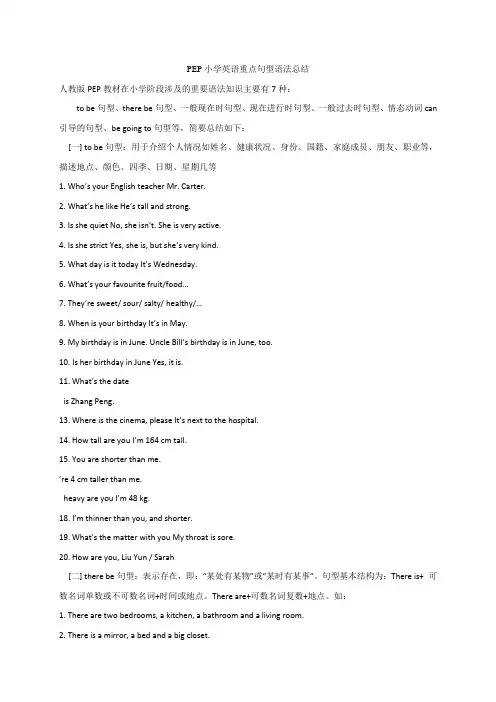
PEP小学英语重点句型语法总结人教版PEP教材在小学阶段涉及的重要语法知识主要有7种:to be句型、there be句型、一般现在时句型、现在进行时句型、一般过去时句型、情态动词can 引导的句型、be going to句型等,简要总结如下:[一] to be句型:用于介绍个人情况如姓名、健康状况、身份、国籍、家庭成员、朋友、职业等,描述地点、颜色、四季、日期、星期几等1. Who’s your English teacher Mr. Carter.2. What’s he like He’s tall and strong.3. Is she quiet No, she isn’t. She is very active.4. Is she strict Yes, she is, but she’s very kind.5. What day is it today It’s Wednesday.6. What’s your favourite fruit/food…7. They’re sweet/ sour/ salty/ healthy/…8. When is your birthday It’s in May.9. My birthday is in June. Uncle Bill’s birthday is in June, too.10. Is her birthday in June Yes, it is.11. What’s the dateis Zhang Peng.13. Where is the cinema, please It’s next to the hospital.14. How tall are you I’m 164 cm tall.15. You are shorter than me.’re 4 cm taller than me.heavy are you I’m 48 kg.18. I’m thinner than you, and shorter.19. What’s the matter with you My throat is sore.20. How are you, Liu Yun / Sarah[二] there be句型:表示存在,即:“某处有某物”或“某时有某事”。
完整版小学英语语法大全 .doc
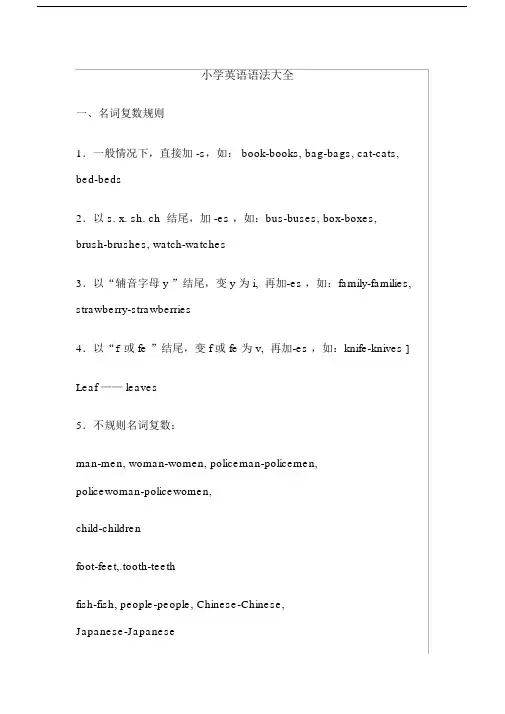
小学英语语法大全一、名词复数规则1.一般情况下,直接加 -s,如: book-books, bag-bags, cat-cats, bed-beds2.以 s. x. sh. ch 结尾,加 -es ,如:bus-buses, box-boxes,brush-brushes, watch-watches3.以“辅音字母 y ”结尾,变 y 为 i, 再加-es ,如:family-families, strawberry-strawberries4.以“f或 fe ”结尾,变 f 或 fe 为 v, 再加-es ,如:knife-knives ] Leaf —— leaves5.不规则名词复数:man-men, woman-women, policeman-policemen,policewoman-policewomen,child-childrenfoot-feet,.tooth-teethfish-fish, people-people, Chinese-Chinese,Japanese-Japanese写出下列各词的复数I _________him _________this ___________her ______watch _______child _______photo ________diary ______day________ foot________ book_______ dress ________tooth_______ sheep ______box_______ strawberry _____peach______ sandwich ______dish_______bus_______man______ woman_______二、一般现在时一般现在时基本用法介绍【No. 1 】一般现在时的功能1.表示事物或人物的特征、状态。
如:The sky is blue. 天空是蓝色的。
小学英语语法大全(完整版)(可打印)
小学英语语法大全第一章名词一、定义名词是表示人或事物名称的词。
它既可以表示具体的东西,也可以是表示抽象的东西。
二、分类1. 名词可以根据意义分为普通名词和专有名词如:john is a studentstudent是普通名词,john是专有名词普通名词前可以用不定冠词a/an, 定冠词the 或不加冠词,专有名词前一般不加冠词,专有名词的首字母要大写。
2. 普通名词又可以分为个体名词、集体名词、物质名词和抽象名词,其中个体名词与集体名词是可数名词,物质名词和抽象名称是不可数名词。
3. 专有名词专有名词是表示人名、地名、团体、机构、组织等的专有名词,多为独一无二的事物。
三、名词的数1、名词分为可数名词和不可数名词。
可数名词——可以数的名词不可数名词——数不清(没有复数)drink?milk tea water orange juice coke coffee porridgefood?rice bread meat fish fruit cake dumplings2、可数名词与不定冠词a(an)连用有数数形式,不可数名词不能与不定冠词a(an)连用,没有复数形式many+可数名词复数much/a little+不可数名词some, any , a lot of (lots of) 两者都可以修饰。
3、可数名词可以直接用数词来修饰不可数名词数词 +量词 +of + 名词对可数名词的数量提问用how many对不可数名词的数量提问用 how much4、不可数名词的量有以下两种表示方法:1) some, much ,a little ,a lot of ,a bit of , plenty of 用等表示多少。
注意既可以与可数名词复数,又可以与不可数名词连用的有:plenty of ,some ,a lot of ,lots of ,most of 等。
如there is much water in the bottle .瓶中有很多水。
(完整版)人教版六年级英语下册重点句型语法总结
PEP小学英语重点句型语法总结人教版PEP教材在小学阶段涉及的重要语法知识主要有7种:to be句型、there be句型、一般现在时句型、现在进行时句型、一般过去时句型、情态动词can 引导的句型、be going to句型等,简要总结如下:[一]to be句型:用于介绍个人情况如姓名、健康状况、身份、国籍、家庭成员、朋友、职业等,描述地点、颜色、四季、日期、星期几等1. Who ' s your English teacher? Mr. Carter.2. What ' s he likeHe' s tall and strong.3. Is she quiet? No, she isn She is very active.4. Is she strict? Yes, she is, but she ' s very kind.5. What day is it today? It ' s Wednesday.6. What ' s your favourite fruit/food …?7. They ' re sweet/ sour/ salty/ healthy/ …8. When is your birthday? It ' s in May.9. My birthday is in June. Uncle Bill ' s birthday is in June, too.10. Is her birthday in Jun e? Yes, it is.11. What ' s the date?12. This is Zhang Peng.13. Where is the cinema, please? It ' s next to the hospital.14. How tall are you ? I ' m 164 cm tall.15. You are shorter tha n me.16. You ' re 4 cm taller than me.17. How heavy are you? I ' m 48 kg.18. I ' m thinner than you, and shorter.19. What ' s the matter with you?My throat is sore.20. How are you, Liu Yun / Sarah?[二] there be句型:表示存在,即:某处有某物"或某时有某事”。
小学英语:1--6年级英语重点短语+句型+语法
小学英语:1-6年级英语重点短语+句型+语法,
孩子背熟,6年不下98
英语是孩子必学的重点科目,有些家长比较重视孩子的语言学习,从小学低年级开始就接触了英语的学习,有写家长认为不必要给孩子过重的负担,孩子直到初中才开始接触英语的学习,这两者之间的学习结果肯定是有很大差异的。
其实,2-14岁是孩子学习语言的最佳时期,想要锻炼孩子的语言能力,家长最好越早培养越好。
今天我整理总结了小学英语3-6年级的英语重点知识,家长们可以为孩子收藏起来,利用空闲时间多多的练习,我相信孩子的英语水平会得到一个很大的提升。
小学六年级英语语法知识点汇总1
小学六年级英语语法知识点汇总语法的学习,需要付出大量的时间和精力。
马上要到(毕业)考试了,为了帮助大家掌握小学英语的基础知识点.接下来是为大家整理的小学(六班级英语)语法知识点汇总,希望大家喜欢!小学六班级英语语法知识点汇总一一、重点(短语):this morning 今天上午this afternoon 今天下午this evening 今天晚上next week 下周tomorrow 明天tonight 今晚post card 明信片comic book漫画书newspaper报纸二、重点句型:1.What are you going to do on the weekend?你周末打算做什么?2.I’m going to visit my grandparents this weekend?这个周末我打算去看望我的外祖父母。
3.Where are you going this afternoon? 你今天下午打算去哪里?4.I’m going to the bookstore.我打算去书店。
5.What are you going to buy?你打算去买什么?6.I’m going to buy a comic book.我打算去买一本漫画书。
三、重点语法:1、What are you going to do?你想做什么?询问他人在未来的打算。
be going to 后面要跟动词的原形。
注意be going to be 意思是打算成为什么,干什么职业。
注意一下(句子)的区别,找出正确回答。
What are you going to do this afternoon?What are you going to buy?What are you going to be?When? are you going?Where are you going?How are you going?Who are you going with?2、this evening 和tonight的区别:this evening指的是今天晚上睡觉以前的时间,一般指晚上十二点以前。
- 1、下载文档前请自行甄别文档内容的完整性,平台不提供额外的编辑、内容补充、找答案等附加服务。
- 2、"仅部分预览"的文档,不可在线预览部分如存在完整性等问题,可反馈申请退款(可完整预览的文档不适用该条件!)。
- 3、如文档侵犯您的权益,请联系客服反馈,我们会尽快为您处理(人工客服工作时间:9:00-18:30)。
各位家您好:了小学到初中的接渡利,助孩子下并督完成英暑假作。
具体操作要求:1 比如您划孩子用暑假中的15 天学,那您可以孩子平均分配完成每日的数量。
2 朗三内容,每日不少于15 分,循往复。
3默写和短两,仍是平均分配原。
注:每日的朗默写您分在下的篇子上和默写本上字,祝您利!英晁老小学句型法[ 一] to be句型:用于介个人情况如姓名、健康状况、身份、国籍、家庭成、朋友、等,描述地点、色、四季、日期、星期几等1.Who’s your English teacher Mr. Carter.2.What ’s he like He’s tall and strong.3.Is she quiet No, she isn’t.She is very active.4.Is she strict Yes, she is, but she’s very kind.5.What day is it today It’s Wednesday.6.What ’s your favourite fruit/food⋯7.They ’re sweet/ sour/ salty/ healthy/⋯8.When is your birthday It’s in May.9.My birthday is in June.Uncle Bill’s birthday is in Jun e, too.10. Is her birthday in June Yes, it is.11. What ’s the dateis Zhang Peng.13.Where is the cinema, please It’s next to the hospital.14.How tall are you I ’m 164 cm tall.15.You are shorter than me.’re 4 cm taller than me.heavy are you I ’m 48 kg.18.I ’m thinner than you, and shorter.19.What ’s the matter with you My throat is sore.20.How are you, Liu Yun / Sarah[ 二] there be句型:表示存在,即:“某处有某物”或“某时有某事”。
句型基本结构为: There is+可数名词单数或不可数名词 +时间或地点。
There are+可数名词复数 +地点。
1. There are two bedrooms, a kitchen, a bathroom anda living room.2.There is a mirror, a bed and a big closet.3.Is there a forest in the park Yes, there is.4.Is there a river No, there isn’t.5.Are there any pandas in the mountains No, there aren ’t.6.Are there any fish in the rivers Yes, there are.[ 三]一般现在时句型:表示习惯性的动作或行为,或现在存在着的状况。
句型基本结构为:主语 +行为动词 +其他。
当主语是第三人称单数时,要在动词原形后面加 s 或 es,其他人称作主语时则用动词原形,在问句及否定句中需要用助动词 do 或 does。
这种句型通常有一些标志词,usually often sometimes never always 等。
Book5:1. What do you have on Thursdays We have English, math and science on Thursdays.2. What do you do on Saturdays I watch TV on Saturdays.3. I do my homework.4.What do you have for lunch on Mondays We have tomatoes, tofu and fish.5.I like fruit. But I don’t like grapes.Book6:1.When do you eat dinner I eat dinner at 7:00 in the evening.2.When do you get up I usually get up at 12:00 noon.3.What do you do on the weekend Usually I watch TV and go shopping.4.Sometimes I visit my grandparents. I often play football.Sometimes I go hiking.5.Which season do you like best I like winter best.6.Why do you like summer/winterBook7:1.How do you go to school, Sarahually I go to school on foot.Sometimes I go by bike.3.I like collecting stamps. He likes collecting stamps, too.4.Does she teach math Yes, she does.5.Does she teach English No, she doesn’t.She teaches math.6.What does your mother do What does your father do7.Where does she work She works in a car company.8.How does she go to work She goes to work by bus.9.Where does the rain come from It comes from the clouds.10. Where does the cloud come from It comes from the vapour.11. Where does the vapour come from It comes from the water in the river.12.The sun shines and the water becomes vapour.13.How do you do thatBook8:1.My nose hurts.2.How do you feel I feel sick.How does Amy feel3.You look so happy.You look sad today.[ 四]在行句型:表示正在行的作或事件,或在短期内正在行的作或存在的情况。
志是: now 也常用在 Look! Listen!等后面。
句型主要构: be ( am, is,are ) +在分 (v. ing) 。
1. What are you doingI ’m doing the dishes.I ’m reading a book.2.Grandpa is writing a letter.Brother is doing homework. Mom is cooking dinner in the kitchen.3.He is writing an e-mail in the study.3.What is it doing It ’s eating bananas.4.What is she doing She’s jumping.5.What are they doing They’re swimming. They’ re climbing trees.6.Are you eating lunch No, we aren ’t.7.Are they eating the honey Yes, they are.8.Is he playing chess Yes, he is.9.Is she counting insects No, she isn ’t.[ 五] 一般去句型:表示去生的而在已束的事件、作或情况。
句型基本构:主 +去式 +其他。
志通常是: yesterday, last week , last year 等,在句与否定句中要用助 did 。
did you do last weekend I played football.2.Did you help them clean their room Yes, I did.did you do yesterday I went fishing.4.Did you read book Yes, I did.5.Did you clean your room No, I didn’t.did you go on your holiday I went to Xinjiang.7.What did you do there I sang and danced with my new friends.8.How did you go there I went by train.此外,一般去也可用来表示客气的。
如:Book3 Unit5, Book 5 Unit3中的:What would you like for lunch I’d like some⋯[ 六]情can引的句型:表示有能力做某事,can 后面的要用原形。
Book4: 1. What can you do I can sweep the floor.I can cook themeals.2.I can water the flowers.3.Can you make the bed No, I can ’t.4.Can you use a computer Yes, I can.Book7: How can I get to Zhongshan Park You can go by the No. 15 bus. [ 七]将来:我的教材中出两种表示将来的句型,即:will和be goingto 句型,主要以 be going to句型主,表示将要做某事或打算做某事。
句型主要构: am/is/are + going to + v.原形。
